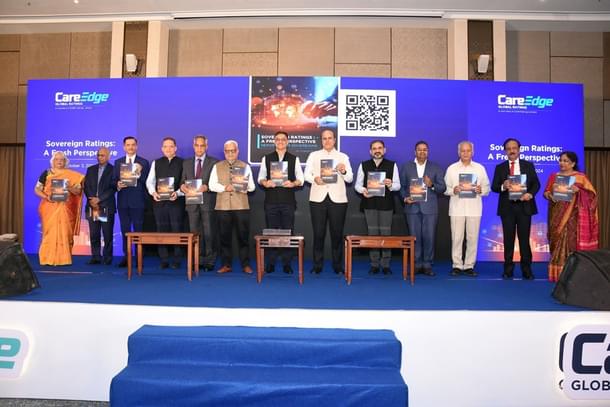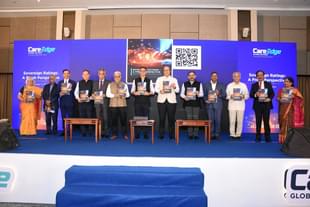Economy
Why Sovereign Ratings By An Indian Agency Should Be Making Headlines And Are Making Headlines
Amit Mishra
Oct 15, 2024, 12:13 PM | Updated Oct 18, 2024, 04:13 PM IST
Save & read from anywhere!
Bookmark stories for easy access on any device or the Swarajya app.


On 3 October, Homegrown Care Ratings Ltd. made history by launching its global sovereign ratings platform. This marks the first time an Indian agency has entered the global ratings space—a space long dominated by Western players.
The platform's first release provided ratings for 39 countries, with India receiving a BBB+ rating, while the United States was rated AA+. Care Ratings aims to expand its coverage to 80 countries by the end of 2025.
Before diving into the impact of this launch, let's take a moment to understand why credit rating agencies (CRAs) hold such power in the financial world.
The top three CRAs—Moody's, Standard & Poor's, and Fitch—dominate the global credit rating market, issuing sovereign credit ratings (SCRs) that measures the general creditworthiness of a country.
Their ratings, expressed in letter grades, assess a government’s ability to repay its debt. Higher ratings indicates greater trust in the ability to repay, and consequently, lower borrowing costs.
Headquartered in the Global North, the United States (US) to be specific, these agencies form an oligopoly in the credit rating market, wielding significant influence over investor perceptions and access to global capital.
However, their dominance has come under scrutiny, particularly after the 2008 financial crisis, with accusations of bias. In recent years, they have been facing charges of ignoring the economic strengths and growth of economies like India.
Behind The Curve
The accusation of bias in global credit ratings is not without basis. India has consistently pitched for better ratings, but agencies tend to apply their own fiscal logic.
Currently, S&P and Fitch rate India at BBB-, while Moody’s places it at Baa3, the lowest possible investment grade. This conservative stance does not correspond to India’s economic realities, leading to growing dissatisfaction among officials and economists.
Sanjeev Sanyal, a member of the Prime Minister’s Economic Advisory Council and a vocal critic of the system, argues that these ratings fail to objectively reflect India’s true economic strength. Many have echoed his concerns, questioning the frameworks used by these agencies and calling for a more accurate evaluation of the country's financial position.
In June 2020, then Principal Economic Advisor in the Ministry of Finance, Sanyal, prepared a detailed presentation titled “Subjective Factors that Impact India’s Sovereign Ratings: What Can We Do About It?” for internal government circulation.
The 36-page document, as reported by The Indian Express, highlighted that 18-26 per cent of a country’s sovereign rating is based on subjective factors, such as governance, political stability, rule of law, corruption, and press freedom.
Sanyal pointed out how this significantly impacts India’s position, stating, "Now this affects our sovereign ratings because 20% of ratings (depend) on this. India oddly does badly in them relative to what I would think would be the case, given the fact that we have a well-established democracy and well-established and regulated financial markets."
According to Sanyal, if India were fairly rated, its sovereign rating should be at least one or two grades higher.
Beyond One-Size-Fits-All
Sovereign ratings cannot follow a standardized “one-size-fits-all” approach; they require a deep, nuanced analysis of each country's unique economic landscape. Local credit rating agencies are often better equipped to understand these subtleties, especially when it comes to their home economies.
Countries like Japan and China have already taken steps to challenge the global ratings monopoly by establishing their own agencies—Japan Credit Rating Agency (JCR) and China Chengxin Credit Rating Group, respectively—to rate their sovereign debts.
India has some well-known credit rating agencies, such as the CareEdge group, CRISIL, and ICRA, to name a few. With Care Ratings stepping into the global arena, India is joining this effort to shift the narrative and add greater representation from the Global South.
The big question is whether Care Edge's sovereign ratings will gain widespread acceptance.
According to Sanyal, this will take time as the new entrant will have to prove its ability to predict credit events better than the incumbents. Building such a track record may take years but a positive beginning has been made. It also opens the door to other areas where Indian agencies can set benchmarks and certifications, noted Sanyal.
Despite the long road ahead, the October launch marks a significant milestone. It has the potential to reconstruct India’s narrative across the globe and influence investment decisions and borrowing costs.




